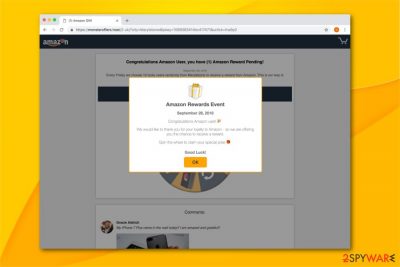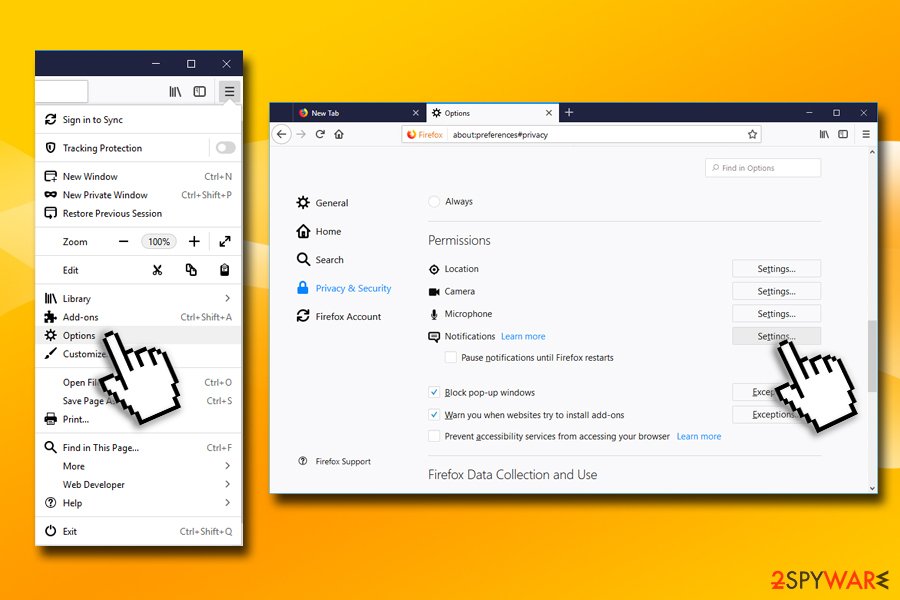Relosoun.com (Virus Removal Guide) - updated Feb 2019
Relosoun.com Removal Guide
What is Relosoun.com?
Relosoun is a phishing site that exposes users to a variety of scams in order to obtain their personal information

Relosoun is a malicious website that tries to trick users into participating in fake surveys to make them install bogus software, subscribe for questionable services or retrieve personal information from them.[1] When Google Chrome, Mozilla Firefox, Safari, or other browser users end up on scam sites like Congratulations Amazon user, Amazon membership rewards, or similar, there is a high chance that their machine is infected with adware – a potentially unwanted program that seeks to gain revenue through advertisement. However, Relosoun developers do not care if the commercial content that is shown is safe, and users might end up losing their money or even expose their personal data, which can later result in identity theft. Additionally, adware is often used to spy on people, recording browsing history and other details to serve targeted ads, pop-ups, in-text links, banners, etc.
| Name | Relosoun |
|---|---|
| Type | Adware |
| Danger level | Medium. No essential system changes, although can lead to unsafe sites |
| Symptoms | Users encounter numerous redirects to questionable sites and receive intrusive ads while browsing |
| Distribution technique | Software bundling |
| Elimination | Use a robust security tool to uninstall Relosoun.com and scan the system with FortectIntego to fix PUP damage |
Users who do not pay attention during the installation of freeware might unconsciously install Relosoun.com adware as well. Once it settles, this PUPs modifies specific browser settings to access information about its users. As a result, this ad-supported program collects various non-personally identifiable data.
The gathered information is exploited to learn more about adware users and target them with customized Relosoun.com ads and redirects. In other terms, developers of the PUP aim to attack as much traffic as possible to the affiliate sites and increase pay-per-click[2] revenue.

Unfortunately, none of the contrivers actually monitor the content they promote and check where Relosoun.com redirect virus leads people. Therefore, some ads might appear in one of the following forms and trigger an automatic installation of malware[3]:
- in-text;
- pop-up;
- banner;
We strongly advise you to not only refrain from clicking suspicious ads but also perform Relosoun.com removal right away. Since adware is hard to identify, the easiest way is to run a full system scan with a reputable security tool. Otherwise, you can find manual elimination instructions below.
Finally, experts suggest installing FortectIntego after you remove Relosoun virus. This tool is designed to optimize the system, fix virus damage and help avoid most common Windows errors. Thus, it could significantly improve your computer's performance in the long-run.
Learn how to unpack software bundles and avoid PUPs
Developers pack adware programs and freeware together. As a result, users download both applications unconsciously and infiltrate ad-supported programs on their systems. Luckily, there are several simple steps to take in order to avoid potentially unwanted programs (PUPs).
The first step is to change Quick/Recommended settings to Custom/Advanced ones. This way you will see additional components which are included in the software bundle. Once you find them, make sure that you opt out all pre-selected boxes that allow installing adware.
Another step is to stay away from commercial content online. This includes advertisements, surveys, suspicious pages, and email spam emails. Researchers[4] note that adware programs can also infiltrate via malicious ads once the user clicks on them. Thus, take precautionary measures.
Uninstall Relosoun.com redirect virus
You have two options to remove Relosoun.com — manual or automatic elimination. The fastest way to complete the uninstall is to run an entire system scan with a reliable malware removal tool. You can either use one from the list below or choose another antivirus.
If you decide to complete Relosoun.com removal manually, check the instructions below. They are designed to guide you through the elimination procedure and show how to reset affected browsers, including Google Chrome, Mozilla Firefox, Safari, Internet Explorer and others.
Finally, if anti-malware software does not find any infections on your device, you should perform the following steps on your browsers to stop Relosoun.com notifications:
Google Chrome:
- Click on Menu (three vertical dots) and select Settings;
- Scroll down and select Advanced;
- Enter Content settings;
- Click on Notifications;
- Scroll down to the Allow section;
- Find Relosoun.com, click on three vertical dots and pick Block.
Internet Explorer:
- Go to Settings > Internet options;
- Locate Privacy tab and pick Settings (in Pop-up blockers section);
- Relosoun.com should be on the list – remove it.
Mozilla Firefox:
- Click on Settings > Options;
- Go to Privacy & Security;
- Go to Permissions and select Settings;
- Find Relosoun.com, click on drop-down menu and select Block.

Safari:
- Click on Safari and pick Preferences;
- Go to Notifications;
- Find Relosoun.com and click on Deny.
Android (Chrome):
- Go to Menu and choose Site settings;
- Pick Notifications;
- A list of Blocked and Allowed notifications from various URLs will appear;
- Select Relosoun.comC and tap on Clear & Reset.
You may remove virus damage with a help of FortectIntego. SpyHunter 5Combo Cleaner and Malwarebytes are recommended to detect potentially unwanted programs and viruses with all their files and registry entries that are related to them.
Getting rid of Relosoun.com. Follow these steps
Uninstall from Windows
If you want to avoid annoying redirects, delete all unknown applications from Windows.
Instructions for Windows 10/8 machines:
- Enter Control Panel into Windows search box and hit Enter or click on the search result.
- Under Programs, select Uninstall a program.

- From the list, find the entry of the suspicious program.
- Right-click on the application and select Uninstall.
- If User Account Control shows up, click Yes.
- Wait till uninstallation process is complete and click OK.

If you are Windows 7/XP user, proceed with the following instructions:
- Click on Windows Start > Control Panel located on the right pane (if you are Windows XP user, click on Add/Remove Programs).
- In Control Panel, select Programs > Uninstall a program.

- Pick the unwanted application by clicking on it once.
- At the top, click Uninstall/Change.
- In the confirmation prompt, pick Yes.
- Click OK once the removal process is finished.
Delete from macOS
Remove items from Applications folder:
- From the menu bar, select Go > Applications.
- In the Applications folder, look for all related entries.
- Click on the app and drag it to Trash (or right-click and pick Move to Trash)

To fully remove an unwanted app, you need to access Application Support, LaunchAgents, and LaunchDaemons folders and delete relevant files:
- Select Go > Go to Folder.
- Enter /Library/Application Support and click Go or press Enter.
- In the Application Support folder, look for any dubious entries and then delete them.
- Now enter /Library/LaunchAgents and /Library/LaunchDaemons folders the same way and terminate all the related .plist files.

Remove from Microsoft Edge
Delete unwanted extensions from MS Edge:
- Select Menu (three horizontal dots at the top-right of the browser window) and pick Extensions.
- From the list, pick the extension and click on the Gear icon.
- Click on Uninstall at the bottom.

Clear cookies and other browser data:
- Click on the Menu (three horizontal dots at the top-right of the browser window) and select Privacy & security.
- Under Clear browsing data, pick Choose what to clear.
- Select everything (apart from passwords, although you might want to include Media licenses as well, if applicable) and click on Clear.

Restore new tab and homepage settings:
- Click the menu icon and choose Settings.
- Then find On startup section.
- Click Disable if you found any suspicious domain.
Reset MS Edge if the above steps did not work:
- Press on Ctrl + Shift + Esc to open Task Manager.
- Click on More details arrow at the bottom of the window.
- Select Details tab.
- Now scroll down and locate every entry with Microsoft Edge name in it. Right-click on each of them and select End Task to stop MS Edge from running.

If this solution failed to help you, you need to use an advanced Edge reset method. Note that you need to backup your data before proceeding.
- Find the following folder on your computer: C:\\Users\\%username%\\AppData\\Local\\Packages\\Microsoft.MicrosoftEdge_8wekyb3d8bbwe.
- Press Ctrl + A on your keyboard to select all folders.
- Right-click on them and pick Delete

- Now right-click on the Start button and pick Windows PowerShell (Admin).
- When the new window opens, copy and paste the following command, and then press Enter:
Get-AppXPackage -AllUsers -Name Microsoft.MicrosoftEdge | Foreach {Add-AppxPackage -DisableDevelopmentMode -Register “$($_.InstallLocation)\\AppXManifest.xml” -Verbose

Instructions for Chromium-based Edge
Delete extensions from MS Edge (Chromium):
- Open Edge and click select Settings > Extensions.
- Delete unwanted extensions by clicking Remove.

Clear cache and site data:
- Click on Menu and go to Settings.
- Select Privacy, search and services.
- Under Clear browsing data, pick Choose what to clear.
- Under Time range, pick All time.
- Select Clear now.

Reset Chromium-based MS Edge:
- Click on Menu and select Settings.
- On the left side, pick Reset settings.
- Select Restore settings to their default values.
- Confirm with Reset.

Remove from Mozilla Firefox (FF)
Fix Mozilla by uninstalling unreliable extensions, add-ons, and plug-ins.
Remove dangerous extensions:
- Open Mozilla Firefox browser and click on the Menu (three horizontal lines at the top-right of the window).
- Select Add-ons.
- In here, select unwanted plugin and click Remove.

Reset the homepage:
- Click three horizontal lines at the top right corner to open the menu.
- Choose Options.
- Under Home options, enter your preferred site that will open every time you newly open the Mozilla Firefox.
Clear cookies and site data:
- Click Menu and pick Settings.
- Go to Privacy & Security section.
- Scroll down to locate Cookies and Site Data.
- Click on Clear Data…
- Select Cookies and Site Data, as well as Cached Web Content and press Clear.

Reset Mozilla Firefox
If clearing the browser as explained above did not help, reset Mozilla Firefox:
- Open Mozilla Firefox browser and click the Menu.
- Go to Help and then choose Troubleshooting Information.

- Under Give Firefox a tune up section, click on Refresh Firefox…
- Once the pop-up shows up, confirm the action by pressing on Refresh Firefox.

Remove from Google Chrome
Follow the instructions below to fix Chrome browser:
Delete malicious extensions from Google Chrome:
- Open Google Chrome, click on the Menu (three vertical dots at the top-right corner) and select More tools > Extensions.
- In the newly opened window, you will see all the installed extensions. Uninstall all the suspicious plugins that might be related to the unwanted program by clicking Remove.

Clear cache and web data from Chrome:
- Click on Menu and pick Settings.
- Under Privacy and security, select Clear browsing data.
- Select Browsing history, Cookies and other site data, as well as Cached images and files.
- Click Clear data.

Change your homepage:
- Click menu and choose Settings.
- Look for a suspicious site in the On startup section.
- Click on Open a specific or set of pages and click on three dots to find the Remove option.
Reset Google Chrome:
If the previous methods did not help you, reset Google Chrome to eliminate all the unwanted components:
- Click on Menu and select Settings.
- In the Settings, scroll down and click Advanced.
- Scroll down and locate Reset and clean up section.
- Now click Restore settings to their original defaults.
- Confirm with Reset settings.

Delete from Safari
Remove unwanted extensions from Safari:
- Click Safari > Preferences…
- In the new window, pick Extensions.
- Select the unwanted extension and select Uninstall.

Clear cookies and other website data from Safari:
- Click Safari > Clear History…
- From the drop-down menu under Clear, pick all history.
- Confirm with Clear History.

Reset Safari if the above-mentioned steps did not help you:
- Click Safari > Preferences…
- Go to Advanced tab.
- Tick the Show Develop menu in menu bar.
- From the menu bar, click Develop, and then select Empty Caches.

After uninstalling this potentially unwanted program (PUP) and fixing each of your web browsers, we recommend you to scan your PC system with a reputable anti-spyware. This will help you to get rid of Relosoun.com registry traces and will also identify related parasites or possible malware infections on your computer. For that you can use our top-rated malware remover: FortectIntego, SpyHunter 5Combo Cleaner or Malwarebytes.
How to prevent from getting adware
Choose a proper web browser and improve your safety with a VPN tool
Online spying has got momentum in recent years and people are getting more and more interested in how to protect their privacy online. One of the basic means to add a layer of security – choose the most private and secure web browser. Although web browsers can't grant full privacy protection and security, some of them are much better at sandboxing, HTTPS upgrading, active content blocking, tracking blocking, phishing protection, and similar privacy-oriented features. However, if you want true anonymity, we suggest you employ a powerful Private Internet Access VPN – it can encrypt all the traffic that comes and goes out of your computer, preventing tracking completely.
Lost your files? Use data recovery software
While some files located on any computer are replaceable or useless, others can be extremely valuable. Family photos, work documents, school projects – these are types of files that we don't want to lose. Unfortunately, there are many ways how unexpected data loss can occur: power cuts, Blue Screen of Death errors, hardware failures, crypto-malware attack, or even accidental deletion.
To ensure that all the files remain intact, you should prepare regular data backups. You can choose cloud-based or physical copies you could restore from later in case of a disaster. If your backups were lost as well or you never bothered to prepare any, Data Recovery Pro can be your only hope to retrieve your invaluable files.
- ^ Watchdog Wednesday: Survey scams that promise a voucher, but steal your info instead…. BBC Watchdog. Investigations into the big names and smaller rogues letting viewers down.
- ^ Pay-per-click. Wikipedia. The Free Encyclopedia.
- ^ Margaret Rouse. malware (malicious software). TechTarget. Fuel Your Pipeline Faster.
- ^ Losvirus. Losvirus. Security and Spyware News.























